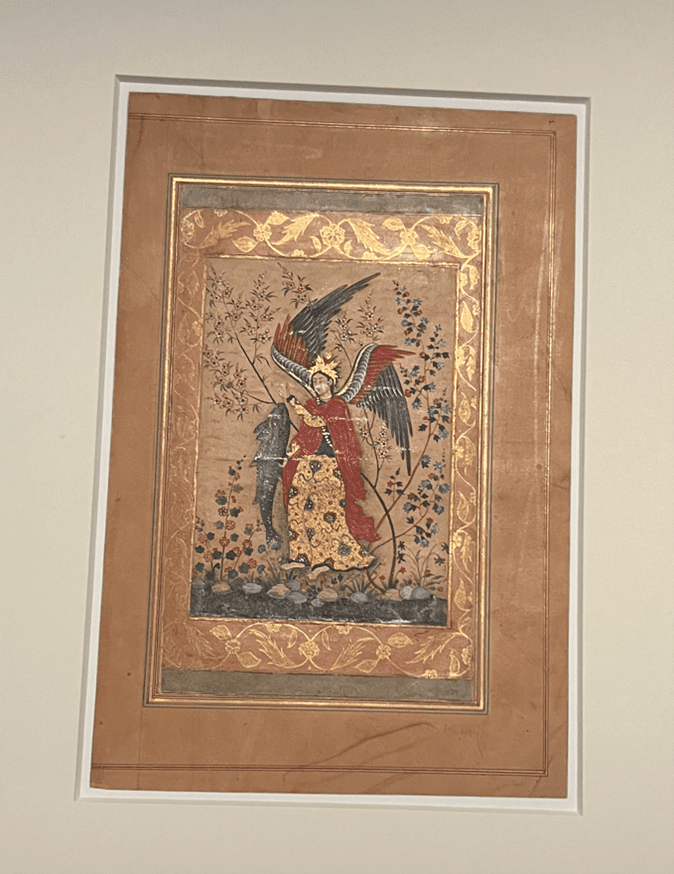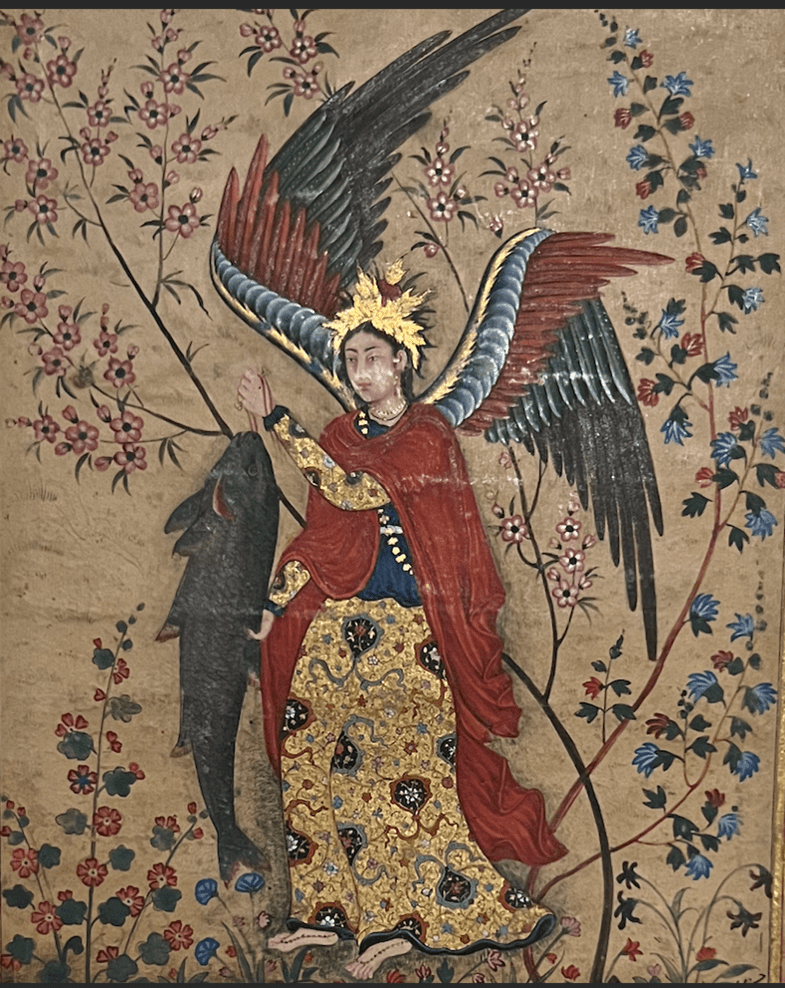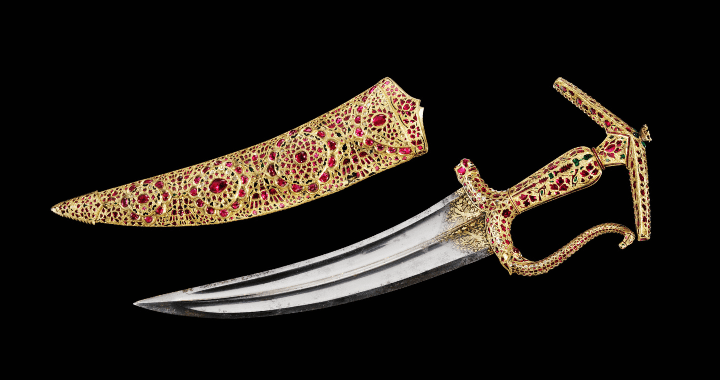As an Islamic art enthusiast, I had the pleasure of recently visiting the exhibition The Great Mughals: Art, Architecture, and Opulence at the V&A. This exhibition focuses on the Golden Age of Mughal art, spanning the reigns of Akbar (1556-1605), Jahangir (1605-1627), and Shah Jahan (1628-1658). The arts flourished during these periods due to economic prosperity, religious tolerance, international trade and its resulting artistic influences, and an immense artistic production across media types. This was reflected in the wide range on display at the exhibition, including objects such as manuscript paintings, arms and armor, ceramics, tiles, and textiles. There were many wonderful items to choose from, but I will explore the topics of daggers and paintings with angels here, which were some personal favorites.
Mughal Daggers
The splendor of the Mughal Empire resulted in bountiful dazzling objects, especially gems and jewelry. Some of the most captivating gems on display at the exhibition were found in ornately decorated imperial daggers. Weapons from each reign had their own distinctive style. My favorite example from this exhibition was a Jahangir nephrite jade dagger with a hilt and scabbard (the sheath attached to the wearer’s belt), all set with emeralds, rubies, and a pearl set in gold.

There are several factors that make this Imperial dagger so noteworthy. Aside from the gems themselves, the size and quality of the nephrite jade would have made this dagger all the rarer, as jade was a coveted material in the 17th-cetury Mughal Empire. The most delightful aspect, in my opinion, was the presence of neither the jade nor the gems, but rather of the delicate red ostriches made of rubies and stacked vertically, picturesquely framed by gold vines of emeralds and rubies. Ostriches were a further symbol of opulence and would have been brought from abroad to Jahangir’s court. While Imperial Mughal daggers are difficult to obtain on the market (such as this dagger owned by Shah Jahan, which sold for well over $3,000,000 in 2019), Mughal daggers and other weapons are frequently offered at auction at a wider range of price points. High-quality 17th-century jade examples with gems have always performed strongly, such as here, here, and here.
In Jahangir-period paintings, daggers were reserved for use by the emperor and others with high rank. Similar daggers are frequently visible in miniature paintings of the various Mughal rulers. This exhibition provided many examples of emperors wearing such daggers on their belts (which are also ornately decorated with gems); one is even visible in the title image for this exhibition!
Angels
One of my other favorite objects from this exhibition was a painting depicting the angel Raphael. There is a common misconception that all religious Islamic art is aniconic. While this rule does apply to art in strictly religious settings, it does not apply to religious art produced by laypeople for lay settings, especially when used as a visual aid in manuscripts (you can learn more about iconic representation and religious art here). The Western term “Islamic art” itself may be a contributor to this confusion, as it serves as an umbrella term encompassing both religious and secular art. Angels are common subjects in Islamic art and appeared in several works in this exhibition. A common story featuring angels used in early Mughal paintings is that of Tobias and the angel Raphael. This story was the focus of the painting The Angel of Tobias by Husayn from the Mughal court workshops during Akbar’s reign around 1590-1600, which depicts the biblical encounter of the angel Raphael assisting Tobias in catching a fish. Raphael is shown here surrounded by colorful flowers and dressed in exquisitely decorated gold clothing. His wings are the most commanding feature, delicately painted in layers of blue, red, green, and black. Raphael is set against a plain beige background, enhancing the boldness of his clothing. The scene is framed with a pattern of gold scrolling leaves with flowers. Angel paintings of similar quality periodically appear in London auctions and perform well, including this example with very similar multicolored wings and this lot from a 2024 sale.


The Great Mughals: Art, Architecture, and Opulence exhibition in on display at the Victoria and Albert Museum through 5 May, 2025 and is definitely worth a visit for both Islamic art novices and seasoned collectors alike! The V&A is also home to impressive permanent collections of antique Islamic art, as well as the Jameel Prize for those interested in contemporary Islamic art.
Originally from San Francisco, California, Ashley Innes (née Crawford) is an experienced Asian art valuer and provenance researcher. Her specialties include ceramics, Buddhist antiques, Indian miniature paintings, Southeast Asian art, and musical instruments.
- Ashley Innes#molongui-disabled-link
- Ashley Innes#molongui-disabled-link
- Ashley Innes#molongui-disabled-link
- Ashley Innes#molongui-disabled-link







